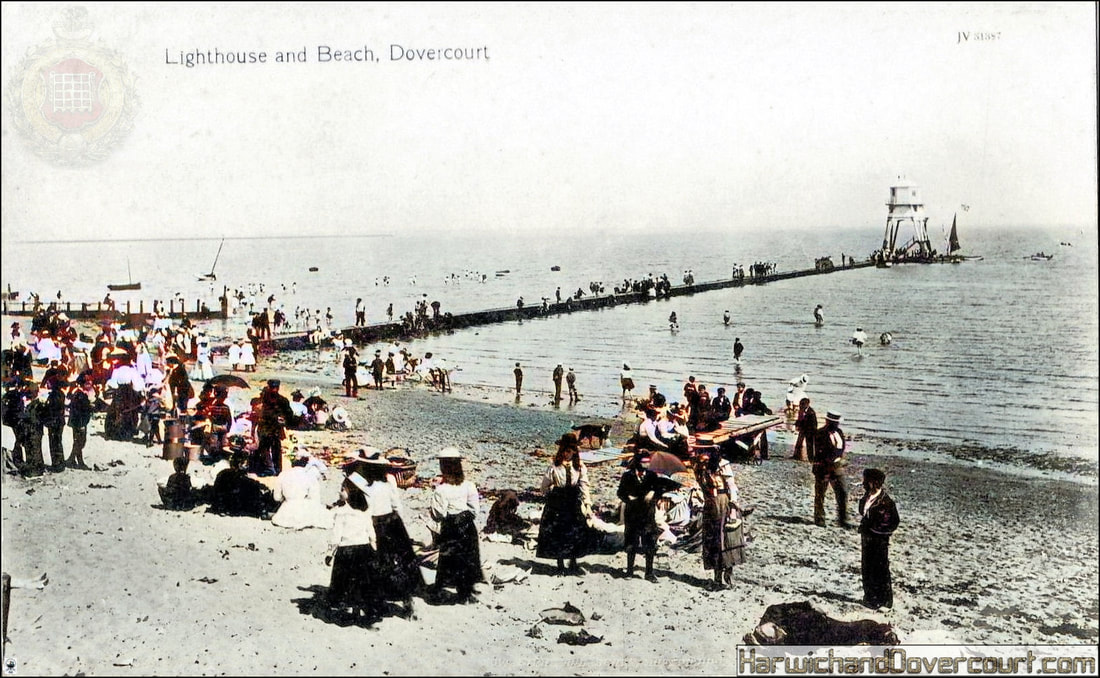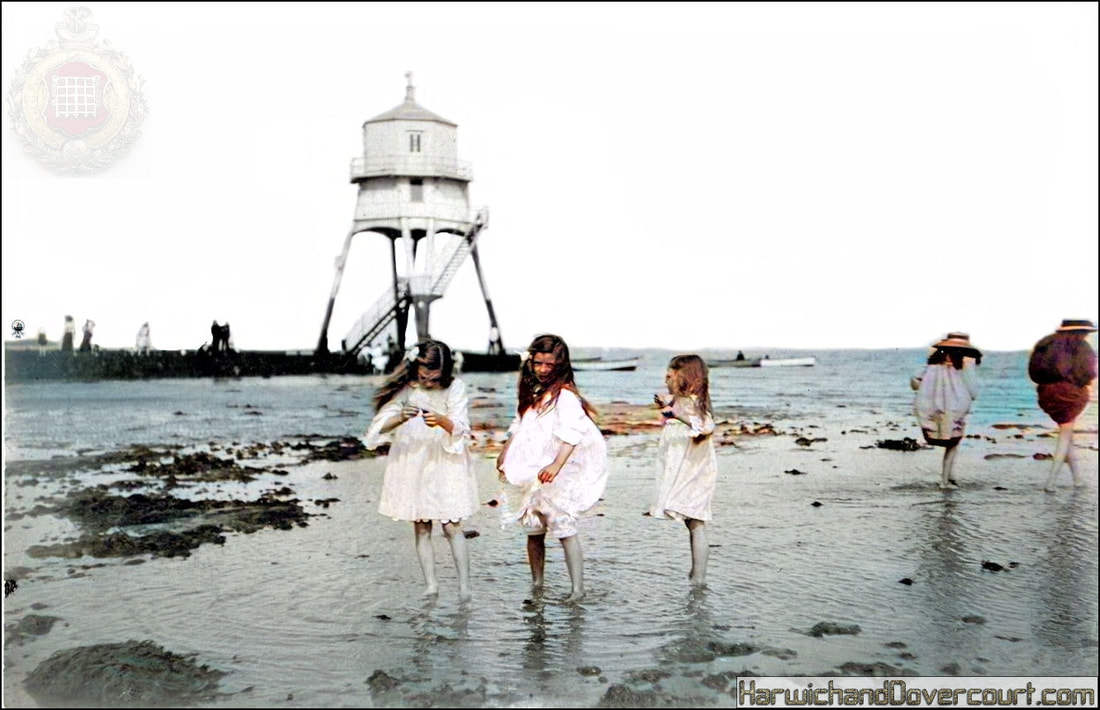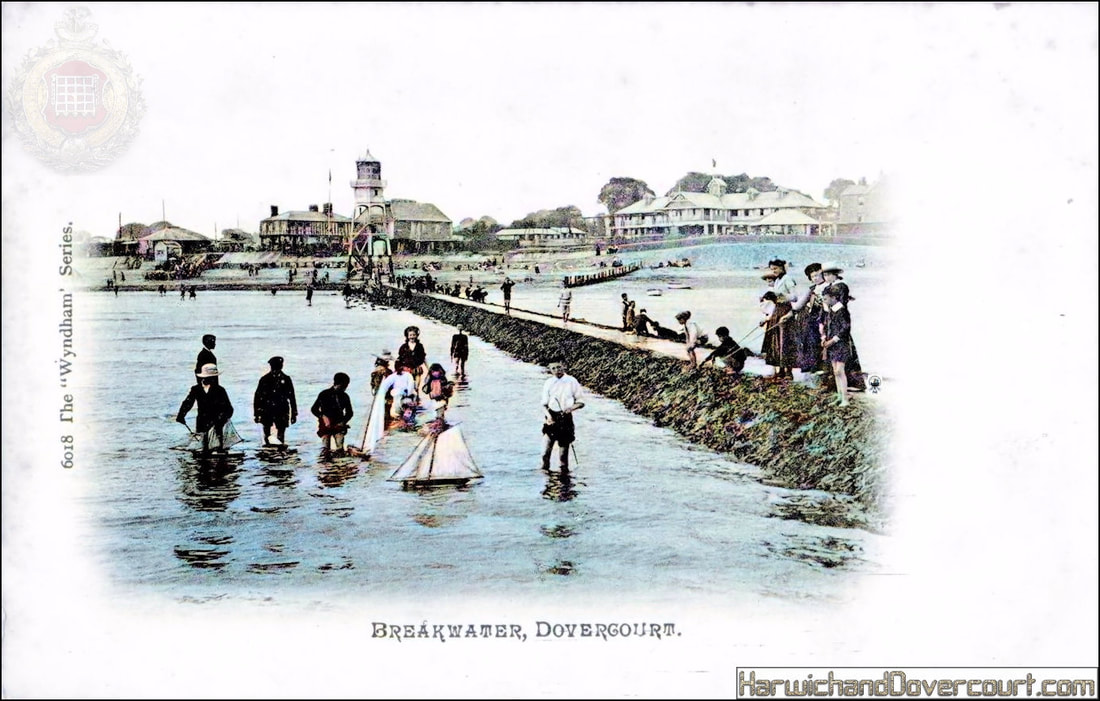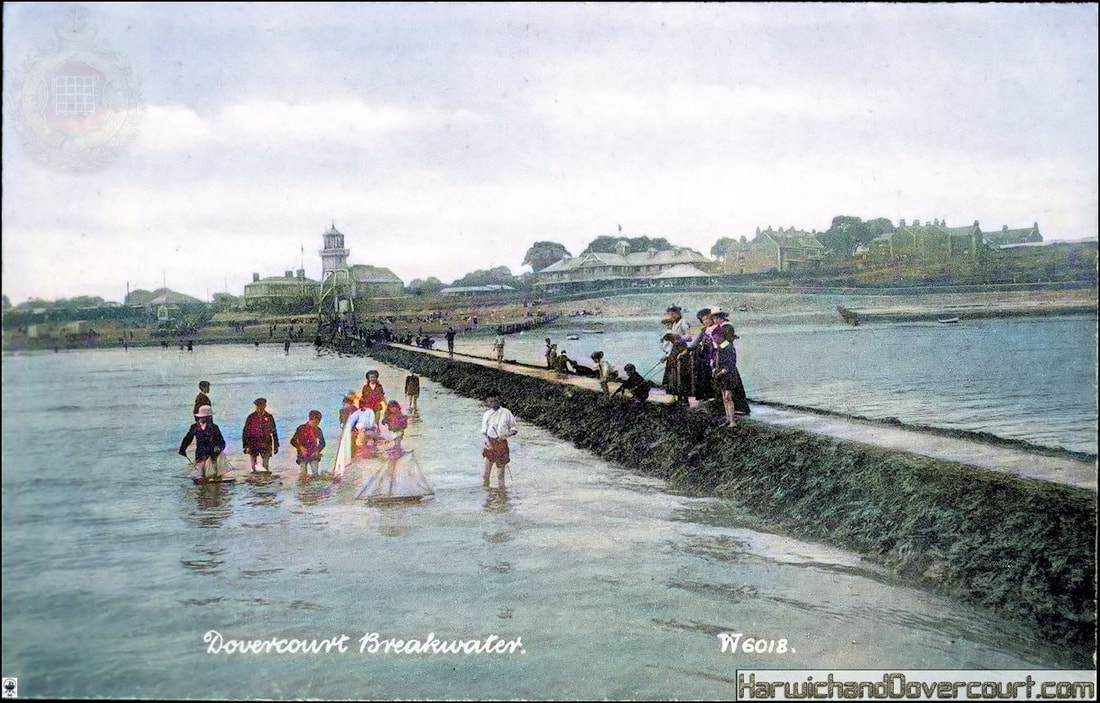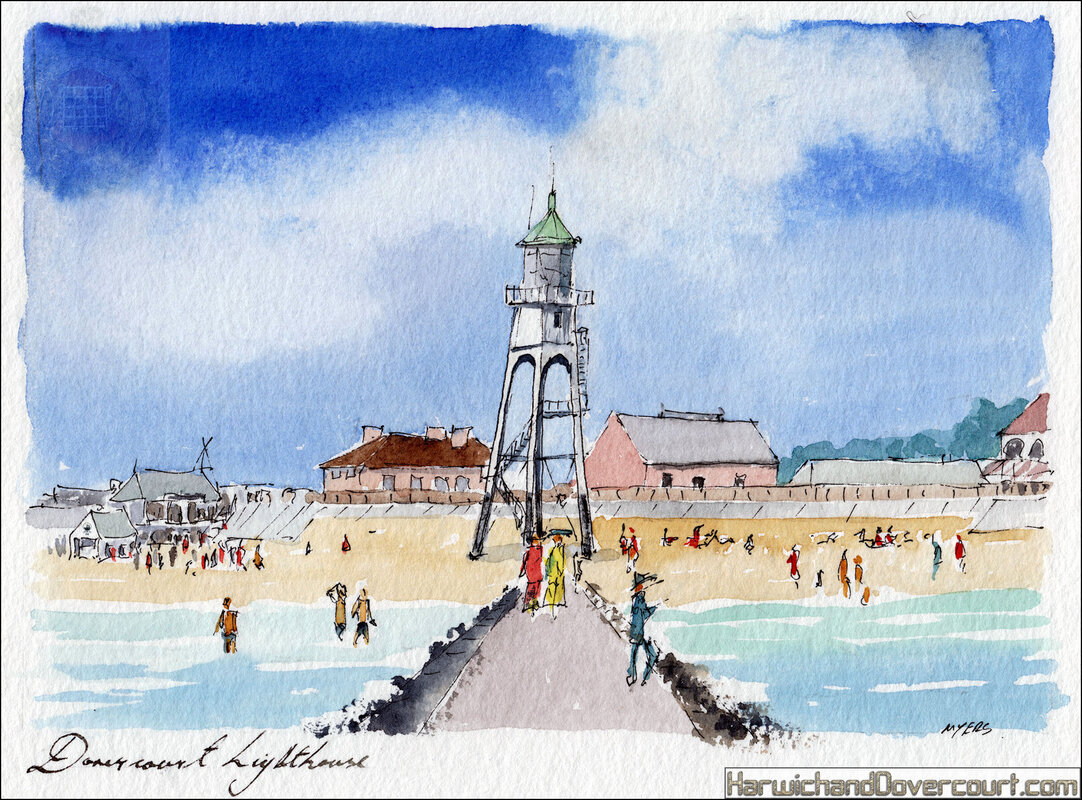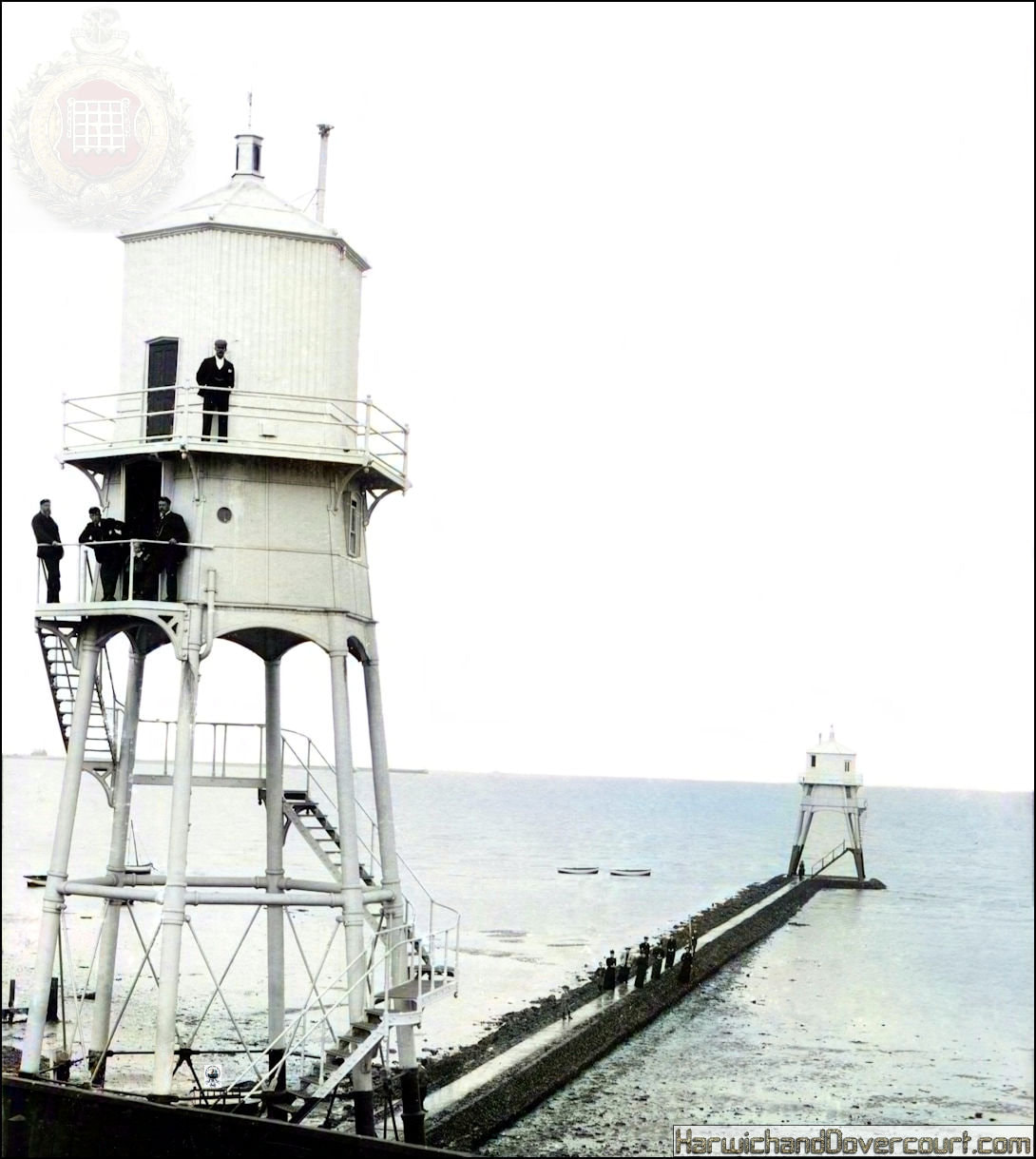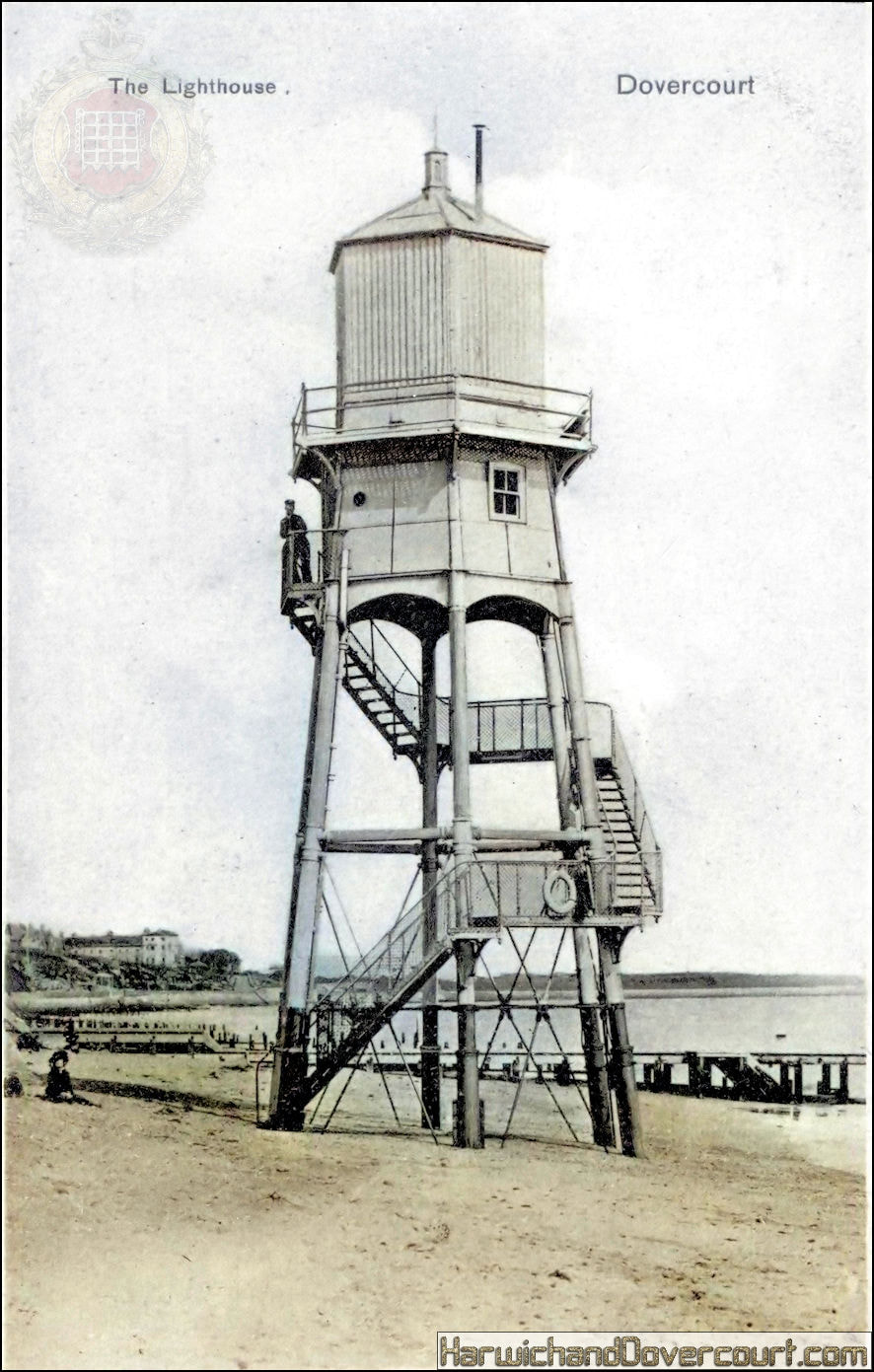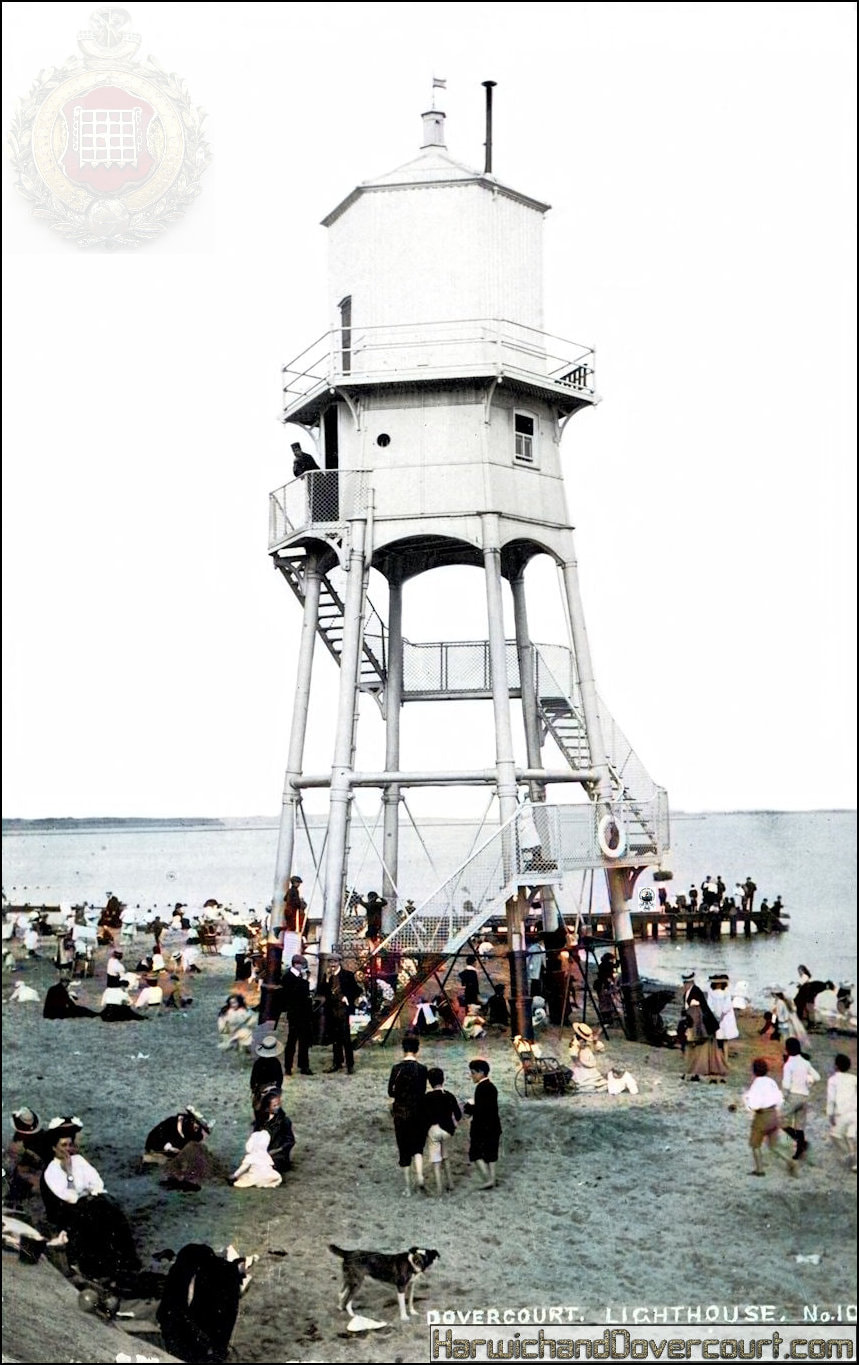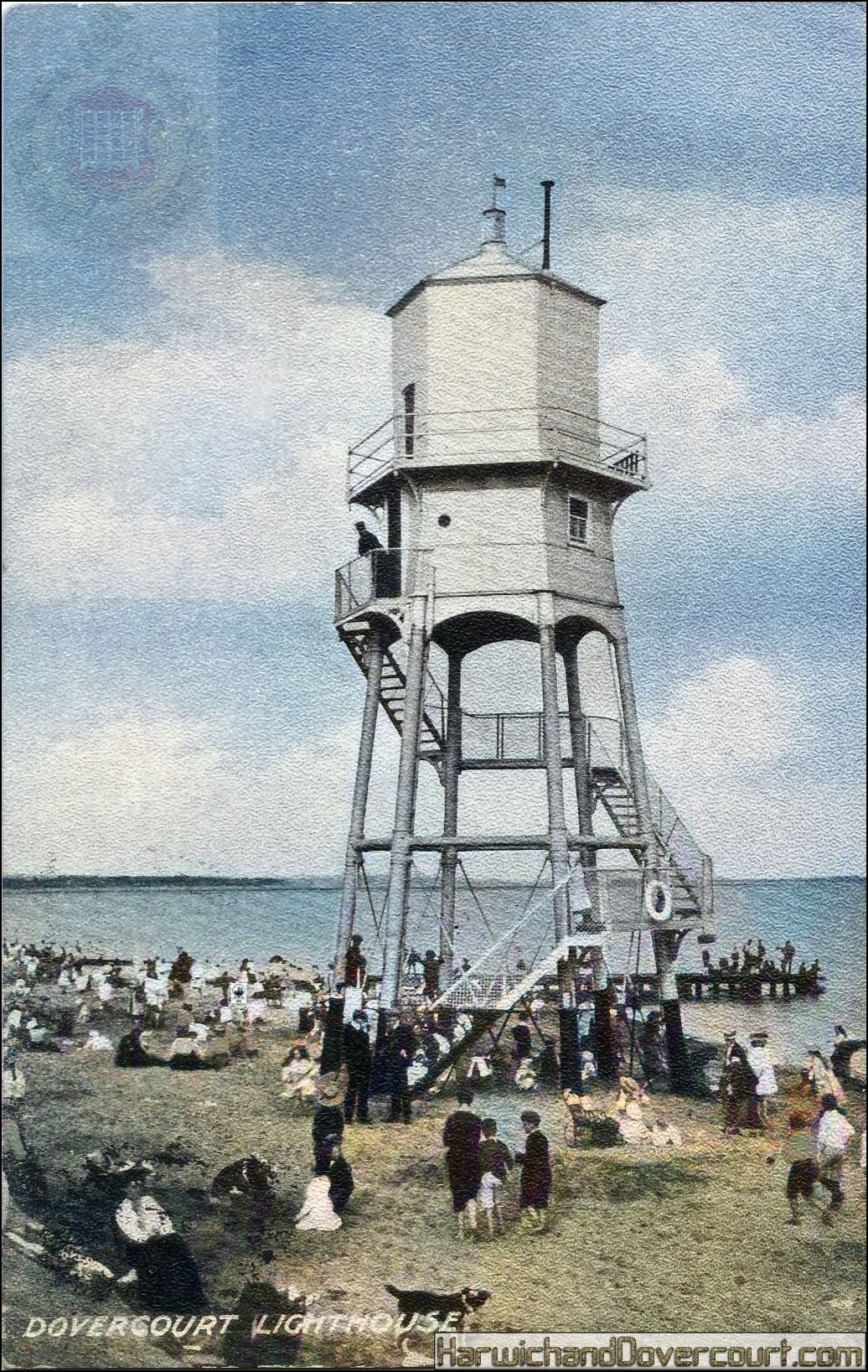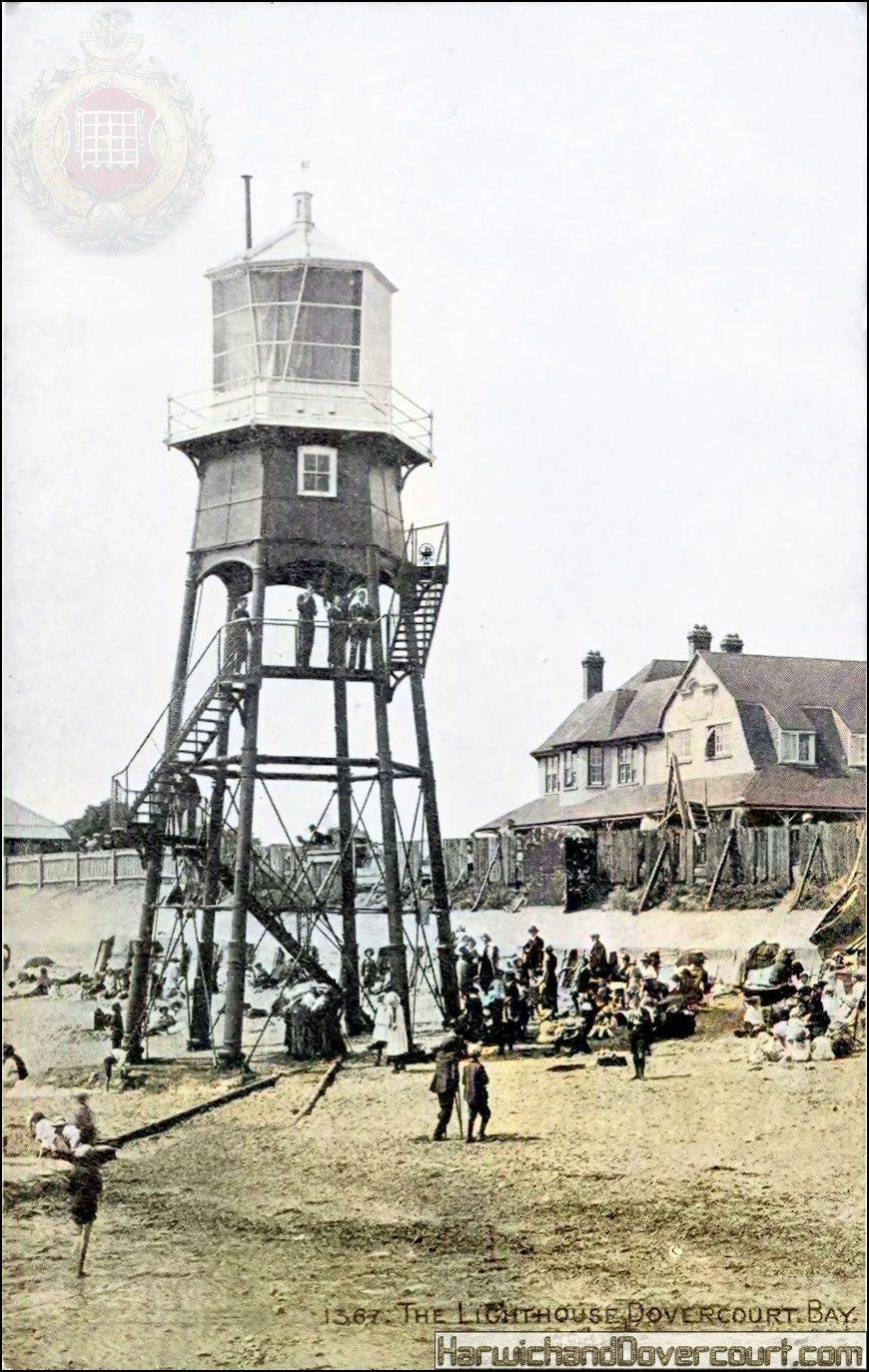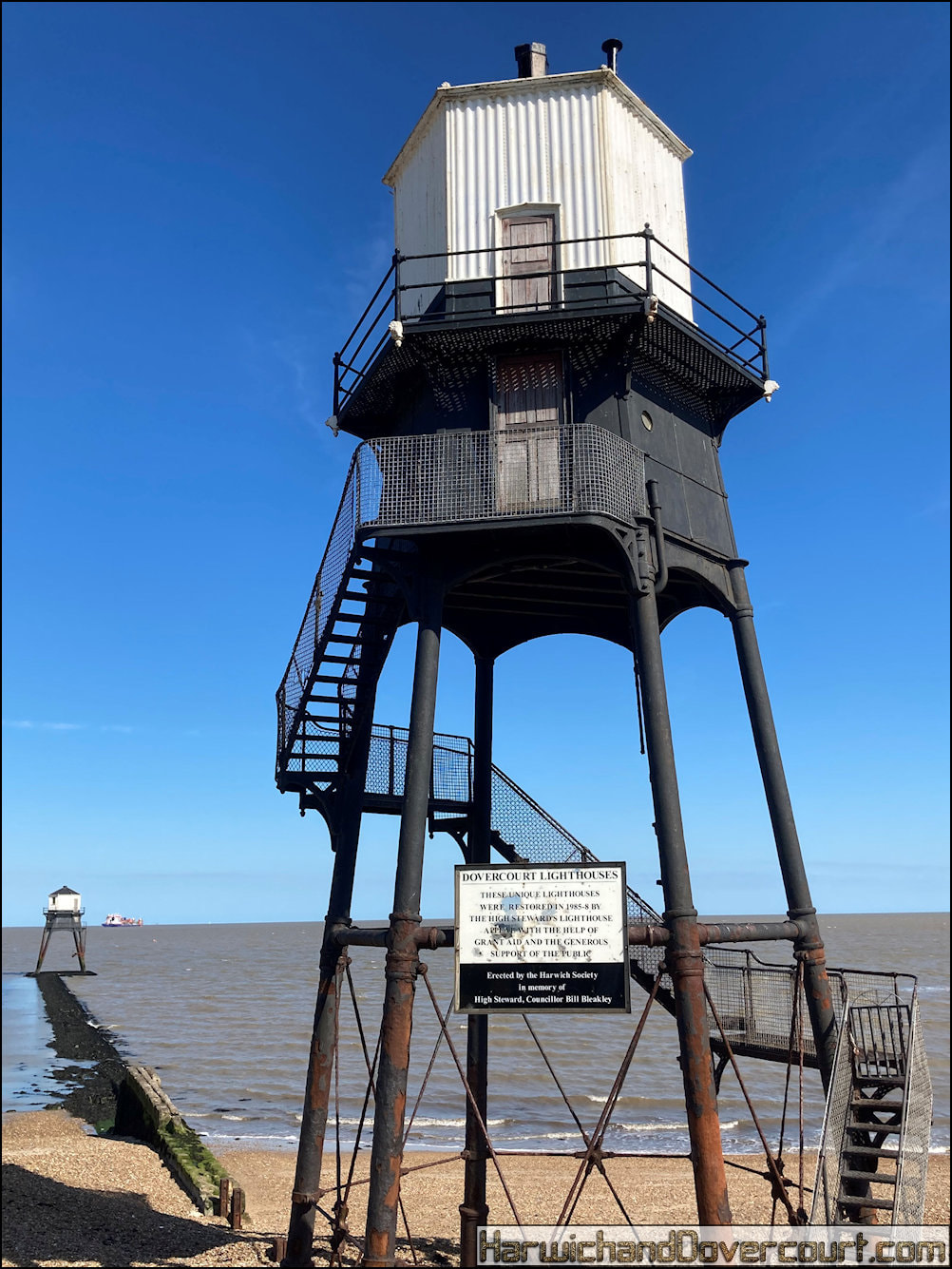The Leading Lights (looking towards Harwich)
~ The Outer Lighthouse & Causeway ~
Rough Seas, Dovercourt Bay (1920) By Wallis H&D FW
#31387 Lighthouse and Beach, Dovercourt (1910) J Valentines H&D FW
Outer Lighthouse (1902) H&D FW
#1191 Sands and Lighthouse, Dovercourt Bay (1904) Pictorial H&D FW
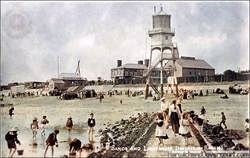
#6018 Breakwater, Dovercourt (1903) The Wyndham Series H&D
W6018 Dovercourt Breakwater (1903) H&D FW
R.N.L.I. Rescue from Outer Lighthouse (1974) H&D FW
#7-744 Lighthouse & Jetty. Dovercourt Beach (1907) H&D FW
An early view looking inland from the Lighthouse pathway, taken in August 1904.
The Phoenix Hotel (which later burnt down) can be seen, behind the Lighthouse.
Note the crowds on the beach appear to be mainly ladies and children.
This early card was part of a series produced by the "Pictorial Postcard Company".
Postcode for the nearest location is CO12 3SS, Click Here for Google Earth imagery.
The Phoenix Hotel (which later burnt down) can be seen, behind the Lighthouse.
Note the crowds on the beach appear to be mainly ladies and children.
This early card was part of a series produced by the "Pictorial Postcard Company".
Postcode for the nearest location is CO12 3SS, Click Here for Google Earth imagery.
#7-744 Lighthouse & Jetty. Dovercourt Beach (1907) H&D FW ~ Art Work
Portrait Photography
The Victorian Lighthouse (1890) H&D FW
The “Keepers” of the Dovercourt Range Lights (@ 1895).
These two lighthouses, were commissioned by Trinity House in 1862 and completed in 1863, served to guide ships towards Harwich harbour (some 1.5km to the north) their different heights enabling the two lights to be aligned on approach. They replaced two late 18th century lighthouses at Harwich (the `Low' and `High' lighthouses) which had become unreliable due to shifting sand bars around the mouth of the Stour estuary. A comprehensive pattern of marker buoys in the harbour approach rendered the new lights obsolete in 1917. The lights escaped demolition, but gradually deteriorated through lack of routine maintenance. A major programme of restoration took place between 1983 and 1988 with the help of William Bleakley's "High Steward Lighthouse Appeal" along with generous donations from the local community that ensured these local icons were not lost to future generations.The Dovercourt Lighthouses are unique examples of early use of screw pile foundations, by which helix or screw bladed iron sections were driven deep into the soft ground in order to provide solid footings for the attached legs.
The inner lighthouse is divided into two storeys: the light keeper’s chamber and the lamp room above. Both are hexagonal in plan to match the pattern of the legs; the lower room is faced with flat iron panels (today these have been painted black to match the frame, but not so in the Victorian era) whilst the upper room clad in corrugated metal and painted white. The light keeper’s chamber has rectangular, iron framed windows facing the shoreline to the south east and north east and a single glazed porthole facing to landward on the south west side. The lamp room is reached via an internal stair, and an external door in the south wall leads out to an encircling iron balcony. The lamp aperture takes up the entire seaward elevation. The windows are modern replacements, although they retain the angles of the three original frames (which are replicated in the roof line above). The roof itself is of a canopy design: lead covered with a central chimney pipe for the oil or gas lantern (long since removed) and a separate vent pipe for the heater in the light keeper’s chamber. The chimney is surmounted by a weather vane which bears the date `1862' in stencil-cut numbers.
The outer lighthouse is similar in overall appearance, but shorter by about 4m and designed with four massive tubular legs (arranged in `V' shaped pairs) to support an octagonal superstructure. The access stairs also terminate with a gate some 2m from the base, but are less elaborate than those of the inner light, reaching the doorway on the southern side in a single flight. The construction of the two storey superstructure is comparable to the inner lighthouse, with matching internal stairs, balcony, window casements and lamp aperture. A single short chimney pipe protrudes from the centre of the leaded canopy roof.
The causeway between the two lighthouses begins with a short section of high wall (or groyne) composed of stone blocks, raised with concrete and set around iron piles. Steps at the seaward end of the wall lead down to the causeway proper which remains accessible for varying intervals during the intertidal period. The causeway measures some 150m in length and 4m in width, with a central avenue of stone flags set over a rubble core and retained to either side by sloping stone facings. The seaward end of the causeway terminates in a square platform (similarly constructed) beneath the outer light. In this Victorian photo, we appear to have a ladies rowing team, out in their Sunday best.
These two lighthouses, were commissioned by Trinity House in 1862 and completed in 1863, served to guide ships towards Harwich harbour (some 1.5km to the north) their different heights enabling the two lights to be aligned on approach. They replaced two late 18th century lighthouses at Harwich (the `Low' and `High' lighthouses) which had become unreliable due to shifting sand bars around the mouth of the Stour estuary. A comprehensive pattern of marker buoys in the harbour approach rendered the new lights obsolete in 1917. The lights escaped demolition, but gradually deteriorated through lack of routine maintenance. A major programme of restoration took place between 1983 and 1988 with the help of William Bleakley's "High Steward Lighthouse Appeal" along with generous donations from the local community that ensured these local icons were not lost to future generations.The Dovercourt Lighthouses are unique examples of early use of screw pile foundations, by which helix or screw bladed iron sections were driven deep into the soft ground in order to provide solid footings for the attached legs.
The inner lighthouse is divided into two storeys: the light keeper’s chamber and the lamp room above. Both are hexagonal in plan to match the pattern of the legs; the lower room is faced with flat iron panels (today these have been painted black to match the frame, but not so in the Victorian era) whilst the upper room clad in corrugated metal and painted white. The light keeper’s chamber has rectangular, iron framed windows facing the shoreline to the south east and north east and a single glazed porthole facing to landward on the south west side. The lamp room is reached via an internal stair, and an external door in the south wall leads out to an encircling iron balcony. The lamp aperture takes up the entire seaward elevation. The windows are modern replacements, although they retain the angles of the three original frames (which are replicated in the roof line above). The roof itself is of a canopy design: lead covered with a central chimney pipe for the oil or gas lantern (long since removed) and a separate vent pipe for the heater in the light keeper’s chamber. The chimney is surmounted by a weather vane which bears the date `1862' in stencil-cut numbers.
The outer lighthouse is similar in overall appearance, but shorter by about 4m and designed with four massive tubular legs (arranged in `V' shaped pairs) to support an octagonal superstructure. The access stairs also terminate with a gate some 2m from the base, but are less elaborate than those of the inner light, reaching the doorway on the southern side in a single flight. The construction of the two storey superstructure is comparable to the inner lighthouse, with matching internal stairs, balcony, window casements and lamp aperture. A single short chimney pipe protrudes from the centre of the leaded canopy roof.
The causeway between the two lighthouses begins with a short section of high wall (or groyne) composed of stone blocks, raised with concrete and set around iron piles. Steps at the seaward end of the wall lead down to the causeway proper which remains accessible for varying intervals during the intertidal period. The causeway measures some 150m in length and 4m in width, with a central avenue of stone flags set over a rubble core and retained to either side by sloping stone facings. The seaward end of the causeway terminates in a square platform (similarly constructed) beneath the outer light. In this Victorian photo, we appear to have a ladies rowing team, out in their Sunday best.

